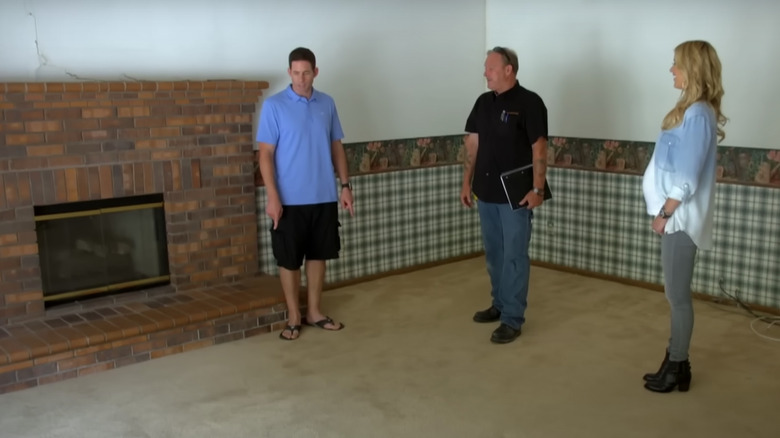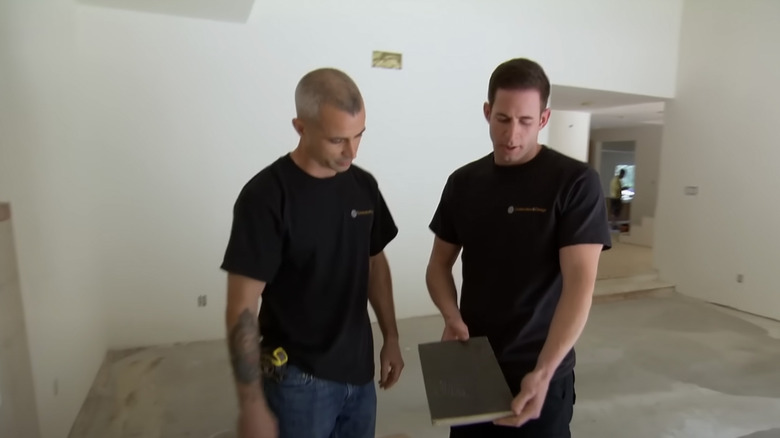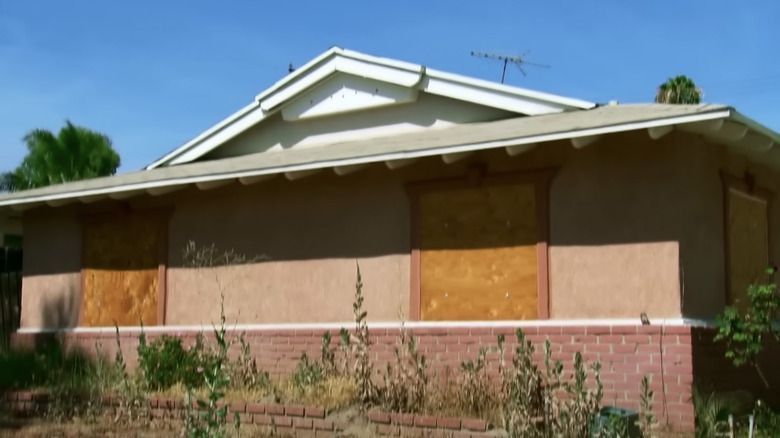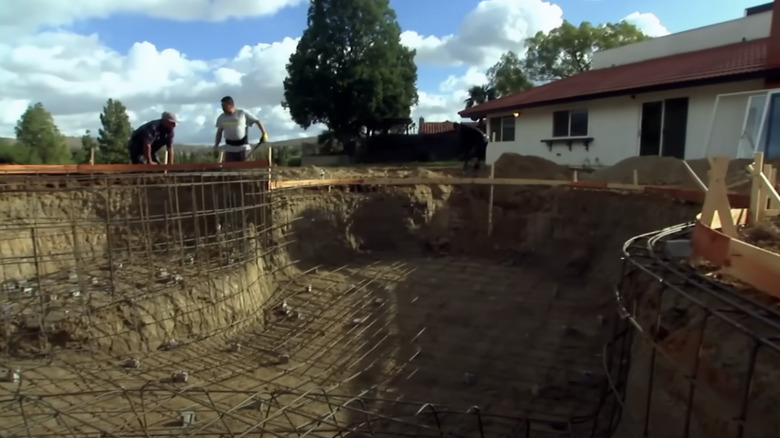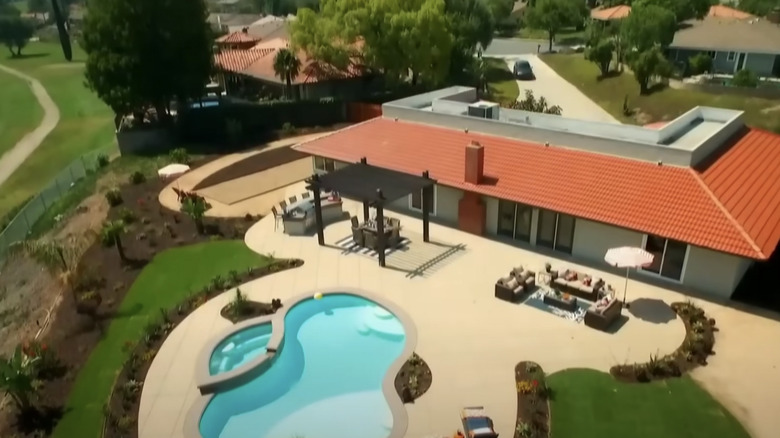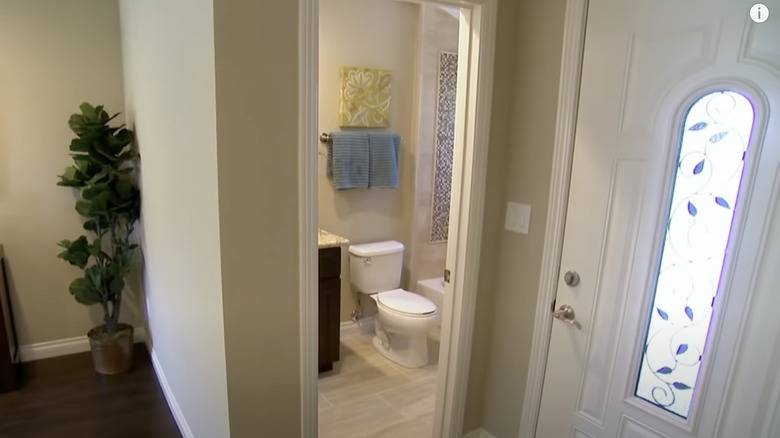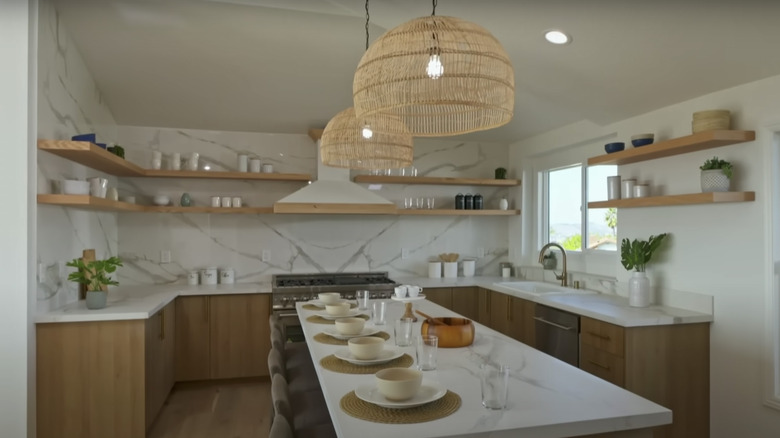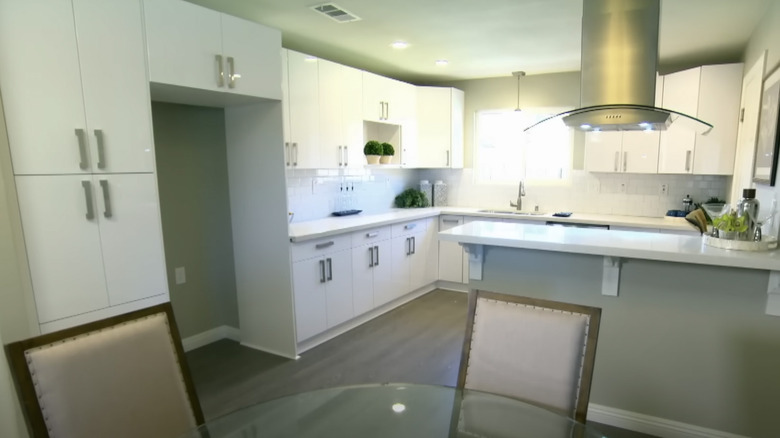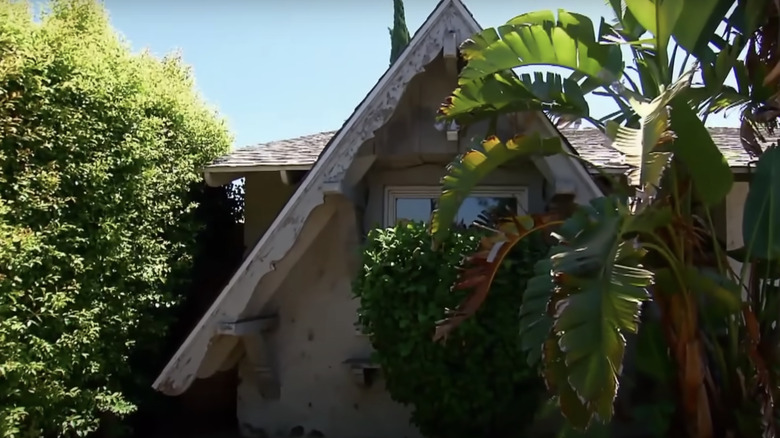Bad Home Advice Dished Out On Flip Or Flop
The hit HGTV show "Flip or Flop" ran for 10 seasons from 2013 to 2022. Famous for drama both on and off the set, the series showcased then-married couple Tarek El Moussa and Christina Hall's expertise in turning even the dumpiest of homes into profitable flips. According to People, although the pair continued hosting the show well after their 2016 divorce, tensions eventually grew, and it was clear the series had run its course. "The writing has been on the wall for a while," the source told the magazine about the show's cancellation. "It was not sudden."
This was a major disappointment to fans of the show, as "Flip or Flop" had long been a look into way more than the California home-flipping industry. It was a glimpse into Christina and Tarek's personal lives, too. They went from a couple in love to parents to a divorced couple still raising children and running a business together. Although the show is only in reruns now, its large back catalog gives fans plenty of opportunities to walk down memory lane. If you are watching for the drama, there will be plenty of it. Yet there were also plenty of remodeling missteps made by the couple, too. If you're looking to enter the house-flipping business, or just renovate your home yourself, avoid these not-so-great tips.
House flippers should purchase a house with foundation issues
Something that can be hard for fans of "Flip or Flop" to remember is that Tarek and Christina are professionals. Not only that, they are professionals with a lot of money behind them should something go wrong. They also probably have a pretty good insurance policy on their house-flipping business. While watching the show, it can be easy to forget these things, but if you are interested in flipping houses yourself — whether for profit or to make your residence — you probably shouldn't purchase the same kind of homes they do. And that includes charming houses with major foundation issues.
As a professional with lots of support, when Tarek came across a home with obvious signs of foundation repair, he still decided to buy it. Yet the walls sported large cracks in multiple locations. Christina was also two inches taller standing in the same room due to the floor sinking. These signs were not a red flag to him because he knew he had the money and the skill set to fix the problem. Yet to newer home flippers, it's a sign to run for the hills because it's a terrible investment.
If you just need to patch up one part of your foundation, you will spend about $4,500 on average. This might not seem too bad, except in this case, the problem was much worse than Tarek and Christina thought. They had to fork out more than planned to fix it ... to the tune of $40,000 and a six-week delay.
You have to splurge on real wood floors
Fans of the show will know that Tarek loves the finer things in life. He is often willing to splurge on more expensive materials. Christina typically went along with her then-husband's ideas, but sometimes even she had to pause due to sticker shock. To make a certain flip shine, Tarek was willing to spend over $25,000 on real wood floors for the entire downstairs. Christina gasped, but he won out in the end. If you want to get the same look at home, you don't have to spend so much money. Instead, think about using a sturdy imitation.
Laminate flooring is a good option for those looking for the chic appearance of wood without the price. Laminate is typically made from a plywood core, while the strong exterior layers have a printed image of the material of your choice. This can be hardwood, stone, or even tile. Because of its well-built center, laminate flooring tends to be very strong. So if you live in a high-traffic home with lots of kids and pets, or just love hosting, it's a great choice. It won't wear down or scuff up as easily as the real thing. Unfortunately, when laminate flooring is damaged, you can't simply polish out the imperfections like in natural wood. The section must be replaced entirely. Luckily, it is typically easy and inexpensive to do so.
Risky house flips always pay off for buyers
Tarek is great at assessing the risk-to-reward ratio for the flips he and Christina purchase. Even the most awful houses tend to flip perfectly and sell for a great profit. But in "real life," that's not always the case. If you are a beginner flipper and approach a house that is boarded up, infested with rodents, and has water damage, it is unlikely you will have a positive result. The biggest risk of flipping a house in real life is the cost. On "Flip or Flop," there is hardly ever a flop. Typically, even the gnarliest of homes turn a profit for the pair, however small. But when fronting your own money, the repairs can quickly skyrocket. This is especially true if you cannot pass an inspection, which Tarek and Christina often don't.
Instead, when selecting a house to flip, be a lot pickier than they ever were. Take a look at two main types of houses. The first is older homes which need a little bit of updating. This shouldn't be a home that needs a new foundation or roof. Instead, a home that just needs a little TLC before meeting its next owners, like a fresh coat of paint and minor lawn rehab. The second is a home near a tourist attraction, like a theme park, beach, or big city. You might be able to make a profit on this flip without too much work, simply because of its prime location.
Installing a pool automatically increases the number of buyers
The "Flip or Flop" team mainly operates in southern California, so a pool could appeal to plenty of buyers. Given the temperate climate of the state, it's possible that having a private pool in the backyard could add some value to the house. However, for those watching at home in different parts of the country, there is more to consider before splashing out on one. It is about a $30,000 initial investment to install a modest in-ground pool from start to finish. While you are enjoying your pool, you also need to factor in ongoing costs like increased utility bills due to the pump and heater, as well as chemicals for water maintenance. You should also add coverage for your pool to your homeowner's insurance policy, lest you be held responsible for any accidents.
If you were to sell, a pool could add about a 7% value increase to your home. To make back your initial $30,000 investment, your home would need to be worth upwards of $430,000 for the math to work out. Unfortunately, the value will be even less if you don't live in a place where the climate lends itself to nearly year-round pool use. Opening and closing the pool each year adds more costs, as does the frustration of having an asset in your home you can't enjoy for months on end.
Put together a yard with no shelter
When creating the "perfect hangout space" in a backyard, the couple failed to consider one important part of being outside: shelter. In this particular episode, Tarek and Christina spent most of their home renovation budget on the backyard instead of the home's interior. Luckily, the house only needed a few cosmetic updates. Viewers can agree that the large backyard was under-utilized before they came along, especially due to the amazing view. Yet in sunny California, a view with no shade is not all that great. The only shelter the then-couple added was a pergola with large slats, which wouldn't block the sun. While the artist's rendering showed an umbrella by the seating area, the final product was missing one.
Shade is an essential part of enjoying an outdoor space. It can keep you cooler on a hot day, or dry when the skies open up. Tarek and Christina were definitely on the right track when staging the house with a pergola; however, leaving it bare was where they fell short. Instead, try adding a bit of greenery to the structure if you decide to recreate the look at home. If you don't want to install a permanent roof with fabric or plastic, using plants can provide just enough shade while adding a fun pop of color. Aside from the pergola, you can also consider adding temporary shelter areas with umbrellas or a retractable awning.
Buying a flip house sight unseen will always work out
Tarek and Christina are big risk-takers, even when the news isn't good and Christina second-guesses the choice. They often purchase a home because of its location and forgo checking what the condition is like inside. When problems arise like water damage and termites, the show has shock value — but it always works out. At the end of the episode, they typically sell the home for record profits, giving each other a high five after another hard day's work. However, in real life, this strategy won't work out more often than not. You could easily lose money.
In fact, skipping the inspection isn't a strategy that is even available to most house flippers. If you don't have a lot of liquid capital at your disposal, you will need to secure a mortgage loan. Yet most mortgage lenders want to ensure the money they lend you can be guaranteed by the property's value. To make sure it is worth the money, you must complete an inspection. Inspections look for things like a bad foundation, an old roof that might need to be replaced, doors that stick, and black mold — which can cause severe lung damage. Unlike Tarek and Christina, don't buy a property that you can't inspect unless you also have seemingly unlimited funds.
Add a full bathroom in the entryway to add value
Taking a shower and using the toilet should be a private thing, so the flipping pair didn't add much value to this home by placing a full bathroom in its entryway. Granted, adding more usable living space to your home can indeed increase its overall value. If you have a three-bedroom, one-bathroom home, adding a second bathroom will increase the property's attractiveness to potential buyers. More importantly, it might also improve your quality of life, as there is less competition for the facilities. Yet the room's location in your home is more important than you might think.
Placing a bathroom near the front door can lead to many embarrassing and awkward moments. This is especially true if you have an open floor plan from the entryway to the main living room, as the home on this episode of "Flip or Flop" did. It can be particularly awkward for guests to enter and exit the toilet in front of everyone else. In addition, when it comes to showering, ideally you want the journey from bedroom to bathroom to be as short as possible. No one should have to leave the home's sleeping area, pass through the main living area, and approach the front door in a towel. If you decide to add a bathroom to your home, place it with more care.
Limited kitchen storage is chic
If you plan to spend nearly $2 million on a house, you will want enough storage for your things. It seemed strange to viewers of "Flip or Flop" that Christina, who usually has such a great eye for design, would double down on floating shelves for this high-end flipped house. Floating shelves are just what they sound like. Instead of the typical cabinets you might find in a kitchen, this option is more of a stripped-down version. Everything sits out on the shelf in the open, to be seen by everyone. In a home this expensive, floating shelves just won't cut it.
Floating shelves are a great storage solution when placed in a living room or bedroom. You can use them to store travel mementos, perfume bottles, or artwork. Yet in a kitchen, open storage makes the room seem cluttered, not chic. Kitchens come with plenty of storage needs: cups, plates, and fancy holiday serving dishes that you only use once a year.
For most, having these items not only fully visible year-round, but day in and day out, would be overwhelming. Floating shelves run into the clutter problem so much that special interior designers are dedicated to assisting clients in clearing them out. When redesigning your kitchen, we recommend you skip floating shelves for more traditional cabinets. If you can't stand the completely closed-off look, consider glass paneling instead.
Create spaces devoid of any color
The classic combination of white and gray is a safe choice design-wise, but it can feel very sterile if done incorrectly. On "Flip or Flop," Tarek and Christina had designated roles in their then-business. Tarek was more of the construction and business mogul. He found properties and was in charge of making the big choices around the structural elements. Christina's role was to finish things off with her keen eye for design. However, Christina sat out on a few episodes while on maternity leave. In her absence, Tarek stumbled, and this simple kitchen in Corona, California, seemed unfinished.
The debate around whether plain white kitchens are boring or brilliant is a long one that still isn't completely settled. The key to coming out on top is adding complementary design elements along with the white. This way, it feels more like a warm, inviting space and less like a hospital room. You can do this by incorporating warmer tones in small accents, like a brassy faucet or cabinet handles. If you prefer a more earthy tone, bring plants into your kitchen to add life. In this staging job, there is too little green for it to be complete. Instead, it just looks unfinished.
Remove all defining features for maximum resale value
Tarek and Christina didn't like the sloping roof on the storybook home they purchased, so they removed it. They assumed such a unique feature would hinder the home's resale value, but the style has plenty of fans. A storybook house looks much like its name would suggest. They typically have an asymmetrical, sloping roofline, a turret fit for a princess, and a woodsy, cottage-like exterior. Think of lots of stone, moss, and things of that nature. They were very popular in the 1920s in the United States. Soldiers from World War I returned home and began creating homes that mimicked the cottages they remembered from small European villages.
The style comes with a lot of history and still has plenty of fans who prefer a more fanciful exterior to their property. Yet Tarek and Christina unfortunately both agreed to completely renovate the home's façade to make it more mainstream. Yet in doing so, the then-couple stripped it of most of its character and what made it appealing in the first place. When considering renovations at home, remember that you don't have to make your house cookie-cutter perfect to sell it.

